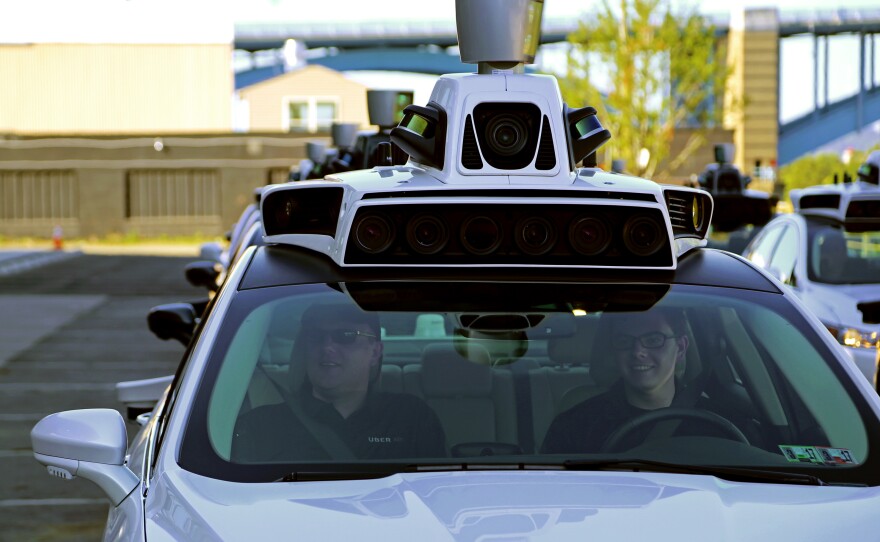Fourteen self-driving Ford Fusions idle in front of Uber's Advanced Technologies Center in Pittsburgh.
On each vehicle, dozens of stationary and spinning cameras collect 1.4 million distance measurements per second, guiding the car on its journey.
Beginning Wednesday, the cars will be deployed on Pittsburgh's streets in a striking experiment by Uber to introduce self-driving technology to its passengers.
"For me this is really important," says Anthony Levandowski, the head of Uber's self-driving car team, "because I really believe that the most important things that computers are going to do in the next 10 years is drive cars."

Levandowski says the company's self-driving technology, like its ride-sharing app, will make the roads safer and less congested, make the air less polluted and increase access to transportation.
Uber and other companies creating autonomous vehicles share a grand vision of the future when people save money and time by not owning their own cars and when deaths from car crashes are few and far between.
Uber introduced the technology to journalists in advance of the rollout, taking us for a ride. It's clear the future is still a long way off.
A self-driving Fusion pulls up, with two Uber employees sitting in front. We sit in the back. On an iPad, I click on a button that says, "Let's ride." The app asks if my seat belt is fastened and tells me there is a two-rider maximum, and I push "all set."
"Here we go," it answers.
As the car pulls out of the parking lot, the iPad shows a loose rendering of our surroundings. The road, parked cars, buildings, other cars on the road, a pedestrian crossing the street.
The ride feels pretty much like a ride in any other car — with an extremely cautious driver. We go maybe one or two miles an hour over the speed limit. Turns in particular feel painfully slow.
When we get to a light, the car stops. I ask the Uber safety drivers if the car will turn right on red. They say no, it doesn't do anything that might be remotely risky. And when we come up behind a car that is parallel parking, our vehicle slows down and waits, rather than change lanes to go around it.
Later, when a parked car blocks our lane, the Uber driver takes over to go around it. The driver says the car could have navigated that situation, but in the interest of safety he decided to go manual.
It's a fairly straightforward situation that most human drivers could handle with no problem. And it really drives home the fact that autonomous car technology is in its infancy.
Uber is like the Wright brothers testing the world's first airplane on the coast of North Carolina. Pretty cool. But not terribly practical yet.
"This is early days for us in a lot of ways," acknowledges the director of Uber's Advanced Technologies Center, Raffi Krikorian. "We're learning every single day as we get on the road and we're driving more and more."
Krikorian says they're working not so much on commonplace driving scenarios as on the rare cases: "What does a self-driving car do when a row of ducks crosses in front of the [car], for example?"
That's one of the questions Uber is hoping to answer as it expands its pilot program in Pittsburgh. A couple thousand users have been selected to participate, and the next time they request an Uber, they could end up in a self-driving car.
Along with a couple of Uber employees. In case of ducks.
Copyright 2022 90.5 WESA. To see more, visit 90.5 WESA. 9(MDAzMjM2NDYzMDEyMzc1Njk5NjAxNzY3OQ001))





